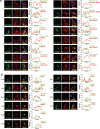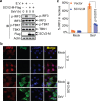Severe acute respiratory syndrome coronavirus 2 (SARS-CoV-2) membrane (M) protein inhibits type I and III interferon production by targeting RIG-I/MDA-5 signaling
- PMID: 33372174
- PMCID: PMC7768267
- DOI: 10.1038/s41392-020-00438-7
Severe acute respiratory syndrome coronavirus 2 (SARS-CoV-2) membrane (M) protein inhibits type I and III interferon production by targeting RIG-I/MDA-5 signaling
Abstract
Coronavirus disease 2019 (COVID-19), caused by severe acute respiratory syndrome coronavirus 2 (SARS-CoV-2), has quickly spread worldwide and has affected more than 10 million individuals. A typical feature of COVID-19 is the suppression of type I and III interferon (IFN)-mediated antiviral immunity. However, the molecular mechanism by which SARS-CoV-2 evades antiviral immunity remains elusive. Here, we reported that the SARS-CoV-2 membrane (M) protein inhibits the production of type I and III IFNs induced by the cytosolic dsRNA-sensing pathway mediated by RIG-I/MDA-5-MAVS signaling. In addition, the SARS-CoV-2 M protein suppresses type I and III IFN induction stimulated by SeV infection or poly (I:C) transfection. Mechanistically, the SARS-CoV-2 M protein interacts with RIG-I, MAVS, and TBK1, thus preventing the formation of the multiprotein complex containing RIG-I, MAVS, TRAF3, and TBK1 and subsequently impeding the phosphorylation, nuclear translocation, and activation of IRF3. Consequently, ectopic expression of the SARS-CoV-2 M protein facilitates the replication of vesicular stomatitis virus. Taken together, these results indicate that the SARS-CoV-2 M protein antagonizes type I and III IFN production by targeting RIG-I/MDA-5 signaling, which subsequently attenuates antiviral immunity and enhances viral replication. This study provides insight into the interpretation of SARS-CoV-2-induced antiviral immune suppression and illuminates the pathogenic mechanism of COVID-19.
Conflict of interest statement
The authors declare no competing interests.
Figures







Similar articles
-
SARS-CoV-2 ORF9b antagonizes type I and III interferons by targeting multiple components of the RIG-I/MDA-5-MAVS, TLR3-TRIF, and cGAS-STING signaling pathways.J Med Virol. 2021 Sep;93(9):5376-5389. doi: 10.1002/jmv.27050. Epub 2021 May 9. J Med Virol. 2021. PMID: 33913550 Free PMC article.
-
Middle East Respiratory Syndrome Coronavirus Nucleocapsid Protein Suppresses Type I and Type III Interferon Induction by Targeting RIG-I Signaling.J Virol. 2020 Jun 16;94(13):e00099-20. doi: 10.1128/JVI.00099-20. Print 2020 Jun 16. J Virol. 2020. PMID: 32295922 Free PMC article.
-
SARS-CoV-2 NSP7 inhibits type I and III IFN production by targeting the RIG-I/MDA5, TRIF, and STING signaling pathways.J Med Virol. 2023 Mar;95(3):e28561. doi: 10.1002/jmv.28561. J Med Virol. 2023. PMID: 36755358
-
Type I and III interferon responses in SARS-CoV-2 infection.Exp Mol Med. 2021 May;53(5):750-760. doi: 10.1038/s12276-021-00592-0. Epub 2021 May 6. Exp Mol Med. 2021. PMID: 33953323 Free PMC article. Review.
-
MDA5 Is a Major Determinant of Developing Symptoms in Critically Ill COVID-19 Patients.Clin Rev Allergy Immunol. 2024 Dec;67(1-3):58-72. doi: 10.1007/s12016-024-09008-z. Epub 2024 Oct 26. Clin Rev Allergy Immunol. 2024. PMID: 39460899 Review.
Cited by
-
Profiling COVID-19 Genetic Research: A Data-Driven Study Utilizing Intelligent Bibliometrics.Front Res Metr Anal. 2021 May 24;6:683212. doi: 10.3389/frma.2021.683212. eCollection 2021. Front Res Metr Anal. 2021. PMID: 34109284 Free PMC article.
-
Emerging variants of concern in SARS-CoV-2 membrane protein: a highly conserved target with potential pathological and therapeutic implications.Emerg Microbes Infect. 2021 Dec;10(1):885-893. doi: 10.1080/22221751.2021.1922097. Emerg Microbes Infect. 2021. PMID: 33896413 Free PMC article.
-
SARS-CoV-2-Specific Immune Response and the Pathogenesis of COVID-19.Int J Mol Sci. 2022 Feb 2;23(3):1716. doi: 10.3390/ijms23031716. Int J Mol Sci. 2022. PMID: 35163638 Free PMC article. Review.
-
Immune damage mechanisms of COVID-19 and novel strategies in prevention and control of epidemic.Front Immunol. 2023 Mar 7;14:1130398. doi: 10.3389/fimmu.2023.1130398. eCollection 2023. Front Immunol. 2023. PMID: 36960050 Free PMC article. Review.
-
SARS-CoV-2 NSP5 and N protein counteract the RIG-I signaling pathway by suppressing the formation of stress granules.Signal Transduct Target Ther. 2022 Jan 24;7(1):22. doi: 10.1038/s41392-022-00878-3. Signal Transduct Target Ther. 2022. PMID: 35075101 Free PMC article.
References
Publication types
MeSH terms
Substances
Grants and funding
- SBK2020042706/Natural Science Foundation of Jiangsu Province (Jiangsu Provincial Natural Science Foundation)/International
- 2018M642662/China Postdoctoral Science Foundation/International
- 81901604/National Natural Science Foundation of China (National Science Foundation of China)/International
- 31730026/National Natural Science Foundation of China (National Science Foundation of China)/International
- 81525012/National Natural Science Foundation of China (National Science Foundation of China)/International
LinkOut - more resources
Full Text Sources
Other Literature Sources
Medical
Molecular Biology Databases
Research Materials
Miscellaneous

